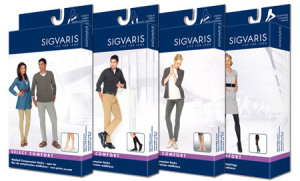 One in four adults suffer from tired, achy, and swollen legs. Poor blood flow may be the cause. Compression stockings can improve this condition. Talk to your doctor or pharmacist to see if compression stockings are right for you.
One in four adults suffer from tired, achy, and swollen legs. Poor blood flow may be the cause. Compression stockings can improve this condition. Talk to your doctor or pharmacist to see if compression stockings are right for you.
Poor circulation can be caused by:
- Age over 40
- Heredity
- Infectious disease
- Long distance air travel
- Long periods of sitting or standing
- Obesity
- Pregnancy
- Sedentary lifestyle
- Surgery or trauma
- Use of hormone medication
Consider compression stockings if you have:
- Heavy, tired, or aching legs
- Initial signs of varicose veins
- Leg ulcers
- Skin discoloration or problems
- Spider veins
- Swollen ankles and feet
- Tension, cramps, or fatigue in legs
If you have any questions about the health of your legs and any symptoms you are feeling, talk to your doctor or one of our pharmacists.
About compression stockings
Compression stockings:
- Come in different lengths and pressures.
- Need to be fitted specifically for you.
- Need to be fitted in the morning when there is less swelling in your legs and ankles.
- Are not a prescription product for most people.
- May be prescribed by your doctor with some conditions.
How do compression stockings help your legs?
 Compression stockings gently squeeze from the bottom of your leg, and make it easier for the blood to move up your legs . Blood moving easily up your legs keeps swelling down in your feet, ankles and lower legs.
Compression stockings gently squeeze from the bottom of your leg, and make it easier for the blood to move up your legs . Blood moving easily up your legs keeps swelling down in your feet, ankles and lower legs.
For more information on the benefits and types of compression stockings available see Sigvaris
Compression stockings in sports
Recreational and competitive athletes wear compression stockings during sports. They feel their performance is better and their recovery is faster because of the increased blood flow in their legs.
They feel their performance is better and their recovery is faster because of the increased blood flow in their legs.
Benefits of wearing compression stockings while doing sports:
- Improved blood flow and circulation in your legs.
- More oxygen to muscle tissue in your legs.
- Fewer pulled muscles and muscle-soreness in your legs from exercise.
- Less lactic acid buildup in your legs during exercise.
- Greater energy, performance, and recovery.
- Reduced shin splints and calf cramps.
Wear and Care
Compression stockings are not your average pair of socks. How you put them on, wear them, and care for them can make a difference in how long they last and how they make your legs feel.
 How to wear compression stockings:
How to wear compression stockings:
Note: You should feel more pressure or tightness around the lower part of your leg at your ankles, with less pressure and tightness higher up near your knees. Compression stockings may feel uncomfortable as you get used to them.
- Wear your stockings for four hours on the first day, and increase the time each day up to a full day.
- Wear them all day or for the full duration of your sport.
- Put them on in the morning and take them off in the evening.
Remove your stockings and contact your pharmacist if:
- You have numbness in your feet or toes.
- Your skin becomes red or itchy.
To put your socks on:
Wear rubber gloves (Sigvaris brand or other). Rubber gloves allow you to smooth the socks over your legs as you put them on. Smoothing the socks prevents holes and tearing from fingernails. Baby powder or cornstarch on your legs can help to pull the socks up your legs.
Note: Do not roll down or bunch your socks when you put them on. Rolling and bunching puts all of the compression at the opening of the sock making it difficult to put your foot in.
- Let any moisturizers on your legs dry.
- Open the top of the sock.
- Step into the top of the sock.
- Pull the top of the sock up until it gets difficult.
- Move your hands to the bottom of the sock.
- Pull from the bottom of the sock until your heel is in the heel of the sock.
- Continue to pull the sock up your leg and smooth it over your leg to remove any wrinkles.
- Do not stretch the sock once it gets difficult; move your hands down and pull up from lower down on your leg.
- Stop pulling the sock up your leg when the top of the sock band is below the bend in the back of your knee by the width of two fingers.
- Do not let the stockings bunch or wrinkle; you will not get the full compression on your legs and you will not get the full benefit from the socks.
